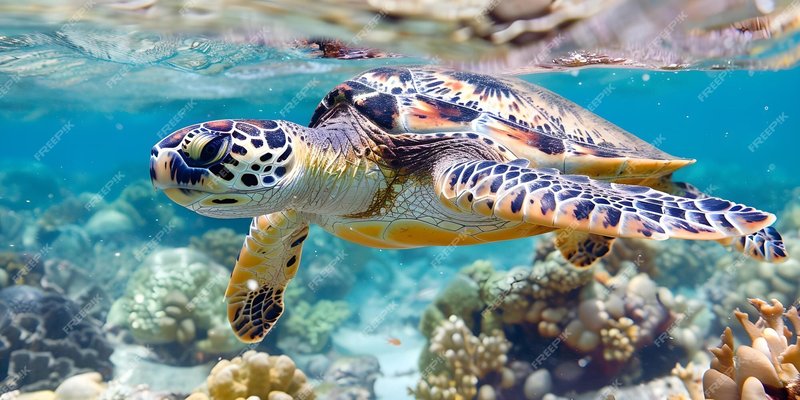
But what exactly does this mean? Hawksbill turtles are vital to coral reefs, not only because they look stunning but also because they help keep the ecosystems balanced. Their diet consists mainly of sponges, which helps prevent any one species from dominating the reef. So, the next time you think about these sea turtles, remember—they’re not just swimming around; they’re environmental superheroes!
Understanding Hawksbill Turtles
Hawksbill turtles (Eretmochelys imbricata) are found in tropical and subtropical waters around the world. Their distinctive shells are not just beautiful; they’re also practical. The shell is narrow and pointed, allowing these turtles to navigate through tight spaces in coral reefs where other creatures might struggle.
You might be wondering why they’re called “hawksbill.” It’s because their beaks are sharp and pointy, resembling the beak of a hawk. This unique feature helps them reach into crevices to grab sponges and other prey. Unfortunately, hawksbill turtles are endangered due to habitat loss, illegal trade, and climate change. Protecting them is crucial not just for their survival but for the health of the oceans.
The Importance of Coral Reefs
Coral reefs are often called the “rainforests of the sea” because of their rich biodiversity. They support a diverse range of marine life, providing shelter and food for countless species. Hawksbill turtles play a significant role in these ecosystems by maintaining sponge populations.
Sponges are essential for the health of coral reefs; they filter water, providing a cleaner environment for other marine organisms. If left unchecked, sponge populations can grow rapidly, smothering corals and disrupting the balance of the ecosystem. By regularly feeding on sponges, hawksbill turtles help ensure that corals can thrive, creating a vibrant underwater habitat.
Feeding Behavior and Habitat
Have you ever watched a hawksbill turtle feeding? It’s quite a sight! These turtles typically forage in shallow waters where coral reefs are abundant. They use their sharp beaks to pry sponges from crevices, and they’re not picky eaters.
In fact, hawksbills have been known to consume over 100 species of sponges! This varied diet ensures that they don’t overgraze any one species, allowing the reef to maintain its diversity. Their feeding habits also stimulate coral growth, as the debris created by their munching helps deposit nutrients back into the ecosystem.
Hawksbill Turtles and Other Marine Species
Here’s the thing: hawksbill turtles don’t just benefit corals. They’re also interconnected with many other marine species. For example, their feeding activity can create habitats for smaller fish, which seek shelter in the areas where sponges have been removed.
This relationship showcases the concept of a keystone species—a species that has a disproportionately large effect on its environment compared to its abundance. When hawksbill turtles thrive, it often leads to an increase in fish populations and overall biodiversity within the reef. This interconnectedness highlights how every species has a role in the marine ecosystem.
The Threats Hawksbill Turtles Face
Despite their importance, hawksbill turtles are facing significant challenges. Habitat destruction, particularly from coastal development and pollution, poses a serious threat to their survival. Coral reefs are also suffering due to climate change, leading to bleaching events that can devastate these habitats.
Additionally, hawksbills are hunted for their beautiful shells, which are often used to make jewelry and ornaments. This illegal trade, combined with other human activities, has caused their numbers to dwindle dramatically. Conservation efforts are critical to ensure that these turtles can continue their vital roles in marine ecosystems.
Conservation Efforts and What You Can Do
Many organizations are working tirelessly to protect hawksbill turtles and their habitats. Conservation efforts include establishing marine protected areas, promoting sustainable fishing practices, and raising awareness about the threats these turtles face.
You can help too! Here are some simple actions you can take:
- Reduce plastic use: Take reusable bags and bottles when you go out.
- Support sustainable seafood: Look for eco-friendly certifications when buying seafood.
- Participate in beach clean-ups: Help keep marine environments clean and safe.
Every little bit helps, and you can play a part in protecting these incredible creatures.
Summary: A Vital Component of Marine Health
Hawksbill turtles are so much more than just a beautiful sight to see while snorkeling. They’re key players in maintaining healthy coral reef ecosystems. By keeping sponge populations in check, they promote biodiversity and help the entire marine community thrive.
As they face numerous threats, supporting conservation efforts is more important than ever. By understanding their vital role, we can appreciate the beauty of hawksbill turtles and the need to protect them and the environments they inhabit. So, the next time you hear about these amazing turtles, remember that they are true ocean heroes, and we can all help keep them swimming strong.
